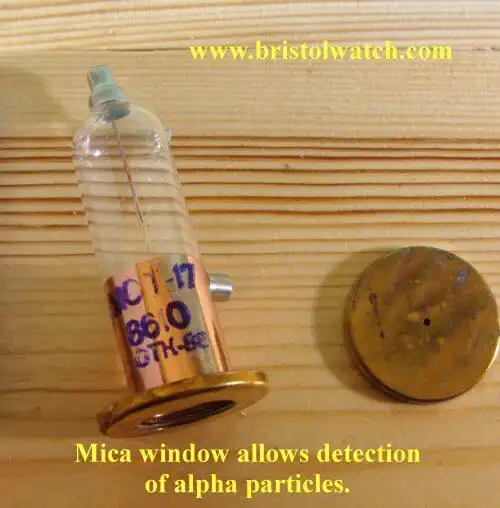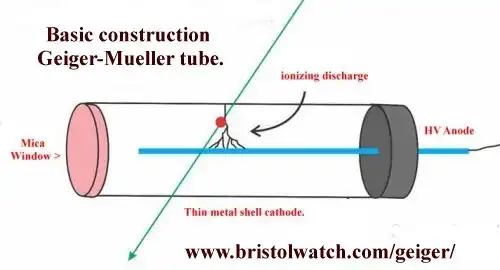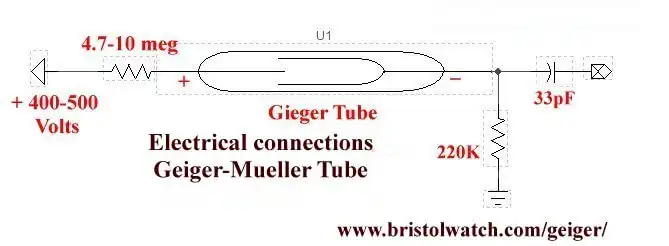
Fig. 1 My Geiger Counter circuit.
Introduction to Geiger-Mueller Tubes and Electronics
by Lewis Loflin
YouTube video Home Built Geiger Counter Radiation Detector
For the power supply see Astable CD4047 High Voltage Power Supply.
Here we will look into the operation of Geiger-Mueller tubes the heart of Geiger counters. Here I'll cover the basics and how to connect the output to an Arduino to count radioactive levels. I bought a Radalert50TM from Ebay as a basis for this series that detects Alpha, Beta, and Gamma particles and radiation. I also bought a Russian Geiger tube to build an actual circuit.
Note I've seen two spellings for a Geiger-Mueller tube, the other is Geiger-Mueller. Mueller is correct.
This is a very general discussion for a general and hobbyist electronics level. Caution: Geiger tubes use a high voltage, but low current power source.
To quote Maxim Integrated:
Many portable radiation monitors include a Geiger-Mueller tube, a simple, two-terminal, gas-filled detector that generates a pulse each time a radiation event (photon or particle) impinges on the tube's sensitive volume. Pulse size and width are independent of the pulse energy or other properties of the event.
Geiger-Mueller tubes are less sensitive to non-gamma-ray radiation, and their dose-rate calibration accuracy is poor. They are widely used because they offer a good compromise in cost/performance/size for applications that require quick detection of a radiation field and a rough estimate of its level...The miniaturization of a portable radiation monitor is limited by the size of the tube which defines sensitivity..

Fig. 2 Geiger Mueller tube with mica window will detect alpha particles.
First, what are we measuring? An alpha particle is a helium atom stripped of both electrons with a large electrical charge and high atomic mass. These particles are very ionizing, (damaging tissue, etc.), but slow and won't penetrate a few sheets of paper. This low level of penetration means we need a Geiger tube with a very thin wall - thus we use a mica window while the rest of tube is thin metal. This is just how my Radalert50TM tube in constructed.
To measure alpha particles the source has to be aimed directly at the mica window which is thin enough to pass alpha particles. Turn the mica window away from the window zero clicks. My test source was the radioactive emitter (Americium 242) from a home smoke detector. Americium 241 is produced from nuclear reactors and is a strong alpha emitter and some low-level gamma rays according to literature.
A mica window can also help detect low-energy Beta particles and weak Gamma and X-ray radiation.
The we have Beta particles which is a negative electron. Their energy levels vary - higher the energy level the more penetrating and ionizing. This is always less ionizing than an alpha particle. A 1/8 inch sheet of aluminum will block Beta particles.
Finally we have Gamma rays and X-rays both forms of electromagnetic radiation with no mass. They are the most penetrating, but the least ionizing. It takes heavy shielding such as several inches of lead or several feet of soil or concrete.
A Geiger-Mueller tube won't detect neutron particles and these are not found outside nuclear reactors, etc. so we won't be concerned with these. They can detect cosmic rays which are high-speed charged particles produced by exploding stars. High flying aircraft, flight crews, etc. are exposed to much higher levels of bombardment which the atmosphere mostly shields against at ground level.
By ionizing gas molecules in the upper atmosphere producing a vapor trail, this is thought to reflect sunlight (insolation) contributing to climate variation - this varies inversely based on the level of solar winds. This complex relationship between solar winds, cosmic rays, volcanic eruptions, axial tilt, etc. all drive climate change making computer models unreliable - the first permanent sea ice in the Arctic appeared only 2.6 million years ago.
See Volcanoes and Climate Change.

Fig. 3 Geiger Mueller tube with no mica window won't detect alpha particles.
Fig. 3 is a cheap Russian Geiger tube off Ebay that won't detect alpha particles. Note the thickness of the tube wall, size, and voltage determine Geiger tube sensitivity. Thick wall tubes are used for heavy radiation environments that can degrade a Geiger tube. A Geiger-Mueller tube WILL NOT indicate the type of radiation.

Fig. 4 Basic Geiger Mueller tube.
Fig. 4 illustrates the construction of the Geiger-Mueller tube in my Radalert50TM. We have a thin copper metal shell connected to the negative side of the power supply. The tube is filled with a low-pressure inert gas such as argon, helium, or neon. It's a form of gas discharge with one important difference. To quote,
The components of the gas fill mixture are an inert gas such as helium, argon or neon which is ionized by incident radiation, and a "quench" gas of 5–10% of an organic vapor or a halogen gas to prevent spurious pulsing by quenching the electron avalanches. This combination of gases is known as a Penning mixture and makes use of the Penning ionization effect.

Fig. 5 Basic electrical connections Geiger-Mueller tube.
In simple terms "radiation" knocks electrons off the gas ionizing the gas - his starts a chain reaction creating a very brief electrical discharge that the ""quenching" gas turns off - else the tube will continue to conduct and glow like a neon lamp.
Fig. 5 show our basic electrical connections for a Geiger-Mueller tube. This requires a high voltage but low current source. A high resistance load resistor (22 mega ohms in the Radalert50TM). A "discharge" is produced whenever radiation or atomic particles enter the tube ionizing the gas producing a narrow voltage spike. In this case I've used a monostable multivibrator to produce a wider, cleaner pulse to be counted by an Arduino or similar microcontroller.
See CD4047 Monostable Multivibrator Circuit

Fig. 6 Basic electrical connections LND712 Geiger-Mueller tube.
Fig. shows the connections for a LND712 Geiger-Mueller tube used in my Geiger counter. For a picture of the LND712 Geiger-Mueller tube see LND712.jpg.
The values of load resistor and required voltage are listed on the specification sheet that comes with the Geiger-Mueller tube. Voltages range from 400V to 1600V. These voltages can be generated in a number of ways, which I'll address on a separate page.
See Astable CD4047 Geiger Counter Power Supply
- Why we should not fear nuclear power.
- Nuclear Graveyards Abound with Life
- What About Humans and Nuclear Radiation?
- Radiation Basics They Should Teach in High School
- Astable CD4047 High Voltage Power Supply
- Geiger Counter and Radioactivity
- Introduction to Geiger-Mueller Counters and Electronics
- CD4047 Monostable Multivibrator Circuit
- Getting Real About Radiation Myths and Hazards
- Uranium Hype-Facts and Virginia Uranium
- Uranium Basics and Isotopes
- Climate Change and Volcanoes
- Geiger Counter Adventures in Radioactivity Literature
- Using TL431A Li-Ion Battery Charger Tutorials
- TL431A Lithium-Ion Cell Charging Circuits
- Charging Multi-Cell Lithium-Ion Battery Packs
- TL431 Over-Voltage, Under-Voltage Detector Circuits
- TL431A Constant Current Source Working Circuits Demo
- Arduino Measures Current from Constant Current Source
- Constant Current Source Theory Testing
- Arduino Controlled Power Constant Current Source
- LM317 Adjustable Current Boost Power Supply
- Constant Current Circuits LM334, LM317
- Build LM317 0-34 Volt Power Supply
- LM334 Constant Current Source with Resistive Sensors
- LM317 High Power Constant Current Source Circuit
- LM317 Constant Current Source Circuits
- Test SCRs and Triacs
- Basic MOSFET Transistor Test Circuits
- High Voltage MOSFET Switching Circuits
- 3 Amp LM741 Op-Amp Constant Current Source
- Current Limiter Testing of Zener Diodes
- Current Limiter for Opto-Coupler Inputs
- LM317 CCS for Light Emitting Diodes
Web site Copyright Lewis Loflin, All rights reserved.
If using this material on another site, please provide a link back to my site.